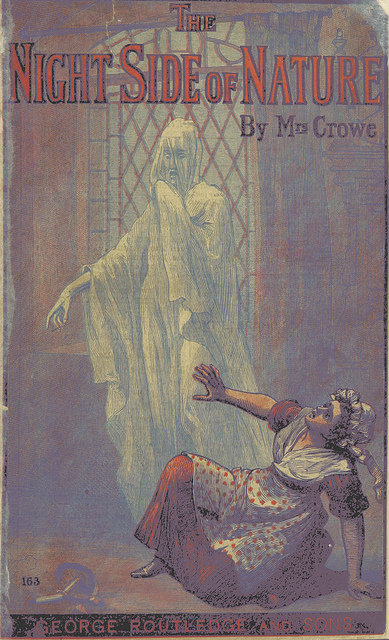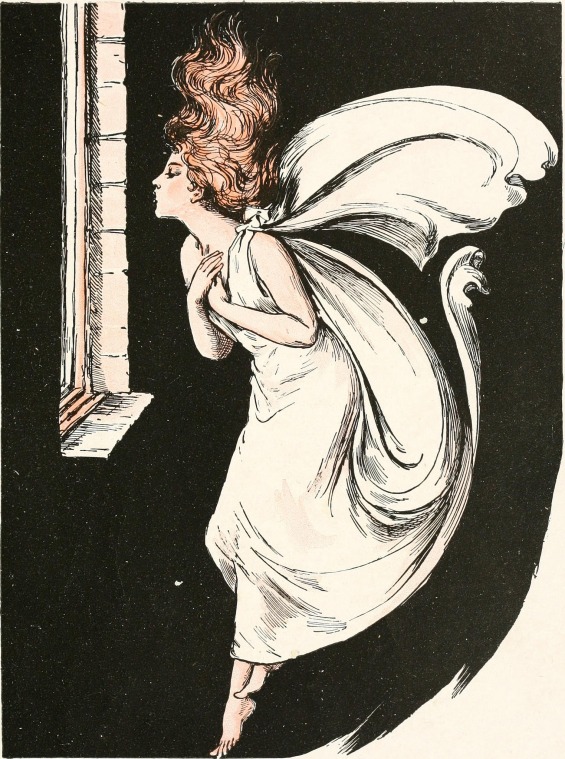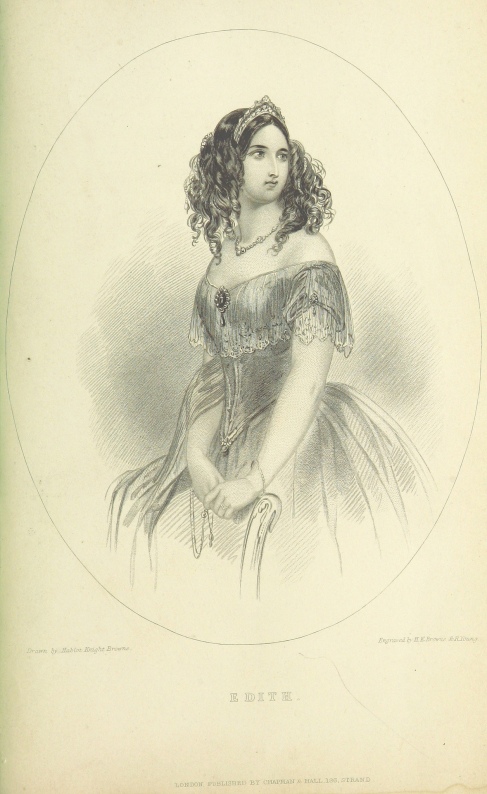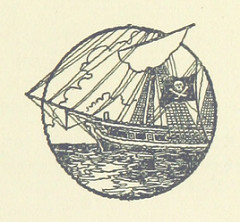
Catherine Crowe (1790-1872) was a noted Victorian author of fiction and folklore, with a strong interest in spiritual matters and the supernatural. Her 1848 book The Night Side of Nature; Or, Ghosts and Ghost Seers is a massive collection of stories and anecdotes on the subject of ghosts and weird phenomena, and was wildly popular, appearing in multiple editions up to 1904.
The Night Side of Nature is a dense but enjoyable read, packed with folklore and supernatural gossip. Like every good ghost story writer, Crowe knew that provenance is a key component of a really effectively spooky tale; she reproduces letters and anecdotes in their entirety, citing their authors where she’s been given permission to do so, and for added authenticity, she includes the real names of locations where uncanny happenings are said to have occurred. One such example is the house at Allanbank, Berwickshire, which in the 17th and 18th centuries was home to the spectral Pearlin Jean, as related below.
Between this book and Crowe’s later volume Ghosts and Family Legends, Crowe’s stories – all allegedly true, or at least vouched for – would provide enough source material to keep a horror writer busy for years.
Here are a couple of excerpts from Chapter 14, “Spectral Lights and Apparitions Attached to Certain Families” on the subject of banshees and other hereditary spooks.
Most persons will remember the story of Lady Fanshawe, as related by herself in her memoirs; namely, that whilst paying a visit to Lady Honor O’Brien [in Ireland, during the Cromwellian period], she was awakened the first night she slept there by a voice, and on drawing back the curtain she saw a female figure standing in the recess of the window attired in white, with red hair and a pale and ghastly aspect.
“She looked out of the window,” says Lady Fanshawe, “and cried in a loud voice, such as I never before heard, ‘A horse! A horse! A horse!’, and then with a sigh, which rather resembled the wind than the voice of a human being, she disappeared. Her body appeared to me rather like a thick cloud than a real solid substance. I was so frightened,” she continues, “that my hair stood on end and my night-cap fell off. I pushed and shook my husband, who had slept all the time, and who was very much surprised to find me in such a fright, and still more so when I told him the cause of it, and showed him the open window. Neither of us slept any more that night, but he talked to me about it, and told me how much more frequent such apparitions were in that country than in England.”
This was, however, what is called a Banshee, for in the morning Lady Honor came to them to say that one of the family died in the night, expressing a hope that they had not been disturbed; for, said she, “whenever any of the O’Briens is on his deathbed it is usual for a woman to appear at one of the windows every night till he expires; but when I put you into this room I did not think of it.”
This apparition was connected with some sad tale of seduction and murder.
This is the only time I’ve heard of a banshee crying for a horse. Perhaps this is a mistranslation of an Irish phrase – or maybe the apparition was a fan of Richard III?

Mrs. Crowe goes on to discuss a more famous and gruesome apparition, associated with the Stuart family, and also originating in a tale of tragedy and betrayal.
I could relate many more instances of this kind, but I wish as much as possible to avoid repeating cases already in print; so I will conclude this chapter with the following account of Pearlin Jean, whose persevering annoyances at Allanbank were so thoroughly believed and established as to have formed at various times a considerable impediment to letting the place. I am indebted to Mr. Charles Kirkpatrick Sharpe for the account of Jean and the anecdote that follows.
A housekeeper, called Betty Norrie, that lived many years at Allanbank, declared she and various other people had frequently seen Jean, adding, that they were so used to her as to be no longer alarmed at her noises.
“In my youth,” says Mr. Sharpe, “Pearlin Jean was the most remarkable ghost in Scotland, and my terror when a child. Our old nurse, Jenny Blackadder, had been a servant at Allanbank, and often heard her rustling in silks up and down stairs, and along the passages. She never saw her; but her husband did.

“She was a French woman, whom the first baronet of Allanbank, then Mr. Stuart, met with at Paris, during his tour to finish his education as a gentleman. Some people said she was a nun; in which case she must have been a Sister of Charity, as she appears not to have been confined to a cloister. After some time, young Stuart either became faithless to the lady or was suddenly recalled to Scotland by his parents, and had got into his carriage, at the door of the hotel, when his Dido unexpectedly made her appearance, and stepping on the fore-wheel of the coach to address her lover, he ordered the postillion to drive on; the consequence of which was that the lady fell, and one of the wheels going over her forehead, killed her.
“In a dusky autumnal evening, when Mr. Stuart drove under the arched gateway of Allanbank, he perceived Pearlin Jean sitting on the top, her head and shoulders covered with blood.
“After this, for many years, the house was haunted; doors shut and opened with great noise at midnight; the rustling of silks and pattering of high-heeled shoes were heard in bedrooms and passages. Nurse Jenny said there were seven ministers called in together at one time to lay the spirit; ‘but they did no mickle good, my dear.’
“The picture of the ghost was hung between those of her lover and his lady, and kept her comparatively quiet; but when taken away, she became worse natured than ever. This portrait was in the present Sir T. G.’s possession.
I am unwilling to record its fate.

“The ghost was designated Pearlin, from always wearing a great quantity of that sort of lace.* Nurse Jenny told me that when Thomas Blackadder was her lover (I remember Thomas very well), they made an assignation to meet one moonlight night in the orchard at Allanbank.
True Thomas, of course, was the first comer; and seeing a female figure in a light coloured dress, at some distance, he ran forward with open arms to embrace his Jenny; when lo, and behold! as he neared the spot where the figure stood, it vanished; and presently he saw it again at the very end of the orchard, a considerable way off. Thomas went home in a fright; but Jenny who came last, and saw nothing, forgave him, and they were married.
“Many years after this, about the year 1790, two ladies paid a visit at Allanbank—I think the house was then let— and passed the night there. They had never heard a word about the ghost; but they were disturbed the whole night with something walking backwards and forwards in their bed-chamber. This I had from the best authority.
“Sir Robert Stuart was created a baronet in the year 1687.”
* A species of lace made of thread. — Jamieson.
Whether the legend of Pearlin Jean is based on a real person’s history, or whether she was always a creature of myth, she has outlasted Allanbank House, and her story is poignant and curious enough that it is still retold today.
Unlike many of our featured books this month, The Night Side of Nature is still in print and available in a modern edition from Cambridge University Press, but you can also get a copy of the British Library’s scanned PDF (from an out-of-copyright edition) here.

I am enthralled by the illustrations. Beautiful!
LikeLiked by 1 person
Thank you very much! We generally find our pictures in the British Library Labs and Internet Archive collections of out-of-print book illustrations on Flickr (https://www.flickr.com/photos/britishlibrary, https://www.flickr.com/photos/internetarchivebookimages/#). There’s a lot of beautiful stuff in there!
LikeLike